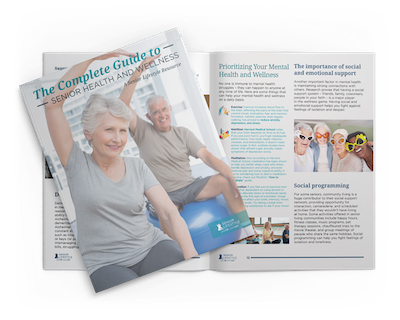Osteoporosis causes bones to become weak or brittle. A person with osteoporosis has a higher risk of bone fracture of the hip, spine, upper arm, pelvis or wrist as their body’s bone regeneration is no longer able to keep up with normal bone loss.
Angel Morrison, Vice President of Clinical Services at Senior Lifestyle, says osteoporosis can be treated but not cured. “For those who live at home or aren’t under a doctor’s care, osteoporosis may not be diagnosed until a fall occurs,” she says.
Estimates say 14.1 million Americans ages 50 and older (about 13%) have osteoporosis, according to the Washington Post. Osteoporosis is more common in older women than men — 27% to 6%, according to a report by the U.S. Centers for Disease Control and Prevention.
Morrison talks about living with osteoporosis, how osteoporosis affects the lives of seniors, and how Senior Lifestyle can help.What Should Seniors Know About Osteoporosis?
A number of factors can increase your risk for the disease. Here are some risk factors and treatments for osteoporosis.
Risk factors
The Mayo Clinic says there are some factors that can increase your risk for osteoporosis:
- Diet. Low calcium intake and eating disorders can contribute, as can certain gastrointestinal surgeries.
- Hormone level. Lowered sex hormones or too much thyroid hormones can be a factor. Osteoporosis is also associated with overactive parathyroid and adrenal glands.
- Lifestyle choices. Excessive alcohol consumption, tobacco use or a sedentary lifestyle can have higher risks.
- Medical conditions. These can include cancer, celiac disease, inflammatory bowel disease, kidney or liver disease, multiple myeloma or rheumatoid arthritis.
- Personal factors. The disease is most common among older people, especially women. White and Asian women are at a higher risk for the disease. Those with a family history or who have a small body frame also are at a higher risk.
- Steroid hormones. Medications used to treat cancer, gastric reflux, seizures or transplant rejection can interfere with the bone-rebuilding process.
Osteoporosis Treatments
There are several osteoporosis treatment options, including medication, hormones, exercise and a calcium-rich diet.
>> Read “7 Best Exercises for Seniors (and a Few to Avoid!)”
The National Osteoporosis Foundation recommends five steps to battle the disease:
- Get daily doses of calcium and vitamin D
- Exercise regularly, focusing on weight-bearing and muscle-strengthening routines
- Quit smoking and limit alcohol intake
- Talk to your health care provider about a bone density test.
- Take an osteoporosis medication if necessary

Download The Complete Guide to Senior Health and Wellness
As people grow older, their health and wellness needs change. Read our eBook, "The Complete Guide to Health & Wellness for Seniors" for everything you need to know about staying healthy and happy as we age.
Download the GuideHow Can a Senior Community Help With Osteoporosis?
Osteoporosis will impact your lifestyle, but Morrison says it doesn’t have to impose a severe change. She says Senior Lifestyle can help a resident with osteoporosis live a more comfortable, fulfilling life.
“Senior Lifestyle is able to assist residents with clinical expertise and oversight in collaboration with your primary health care providers for diagnosis and treatment options,” she says. This care at Senior Lifestyle begins with assessment.
“We have specific assessments that review key indicators related to osteoporosis risk, such as medication treatment, falls, diet and exercise,” Morrison says.
>> Infographic: Are Retirement Communities Safer Than At-Home Care?
Care and Treatment
“Specialized training is provided to our team members regarding treatment options for osteoporosis,” Morrison says.
She says each Senior Lifestyle location coordinates care and treatment as ordered by the primary care physician. This may include therapy options and medication review.
Monitoring
“Early detection and treatment provides the most promising outcomes,” Morrison says. “At Senior Lifestyle, we assess these key areas with a focus on early detection and action items to reduce some of the more serious outcomes.”
Seniors, especially those who already have osteoporosis, are encouraged to undergo regular bone mineral density assessments. These will monitor the strength of bones and the effects of medications and other therapies.
“Senior Lifestyle offers trained medical professionals to assist with coordination of services with local testing and diagnostic providers,” Morrison says.
Healthy Living
Senior Lifestyle locations use exercise and nutrition to help residents thrive.
“Our specially trained team members offer assistance with pain management, encourage active movement and offer weight-bearing exercise programs,” Morrison says. “Staff is also available 24/7 to meet your needs.”
Communities offer balance classes, chair yoga, tai chi, walking clubs and water aerobics, all adapted to senior ability levels, to keep residents healthy and strong.
“We also partner with local therapy providers for physical and occupation orders to assist with weight-bearing regimens that are designed to promote better outcomes,” Morrison says.
Nutrition also factors into the holistic health plan at Senior Living communities.
“Meals are prepared by dedicated and specially trained staff,” Morrison says, “and menus are provided by a registered dietitian.”
Nearly one in six seniors in America faces the threat of hunger or malnourishment, dramatically raising their health risks, according to Medicare Advantage. By contrast, 71% of seniors in retirement communities surveyed by the Administration for Community Living say they eat healthier as a result of nutritional programming.
Residents at Senior Lifestyle communities are served delicious meals each day, combining the joys of dining with the nutrition that experts say residents need to live a healthy life.
>> Read Senior Nutrition: Healthy Meals for the Elderly
Emotional Support
Because older adults are often beset by chronic health conditions such as osteoporosis (according to the CDC, 80% of seniors have at least one condition, and 50% have two or more), they are more at risk of depression.
To offset this risk, seniors need to have connection, security and autonomy in their lives. Senior Lifestyle communities come alongside residents to provide the support they need.
“Daily scheduled programming in our communities includes a spiritual and emotional component to assist with disease processes across the board,” Morrison says.
Learn How Senior Lifestyle Can Help You
Senior Lifestyle communities can provide the medical and physical support needed by those with osteoporosis. Contact us today to find out more or to learn about a community near you.

